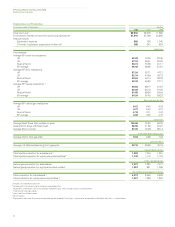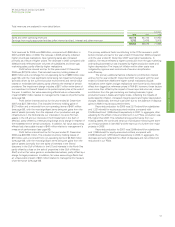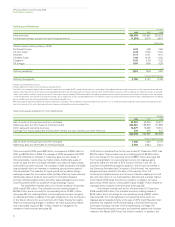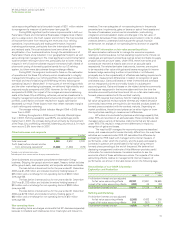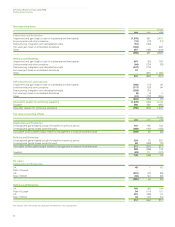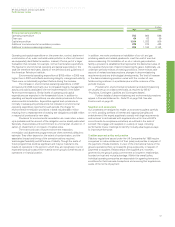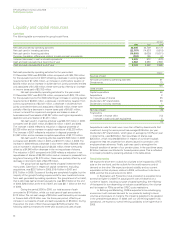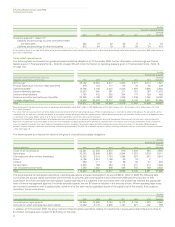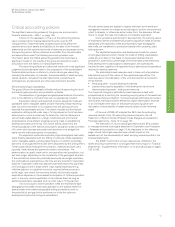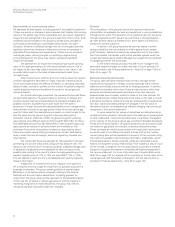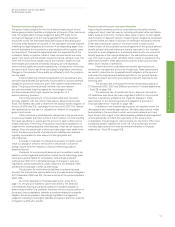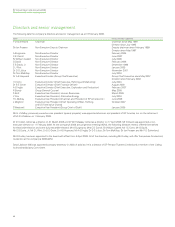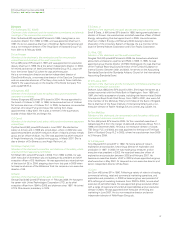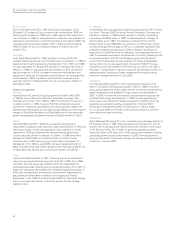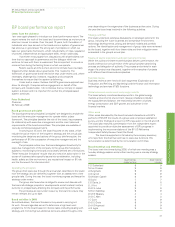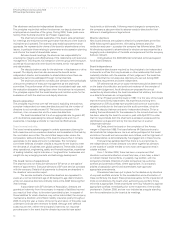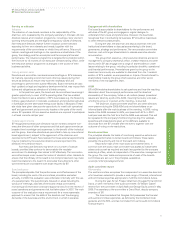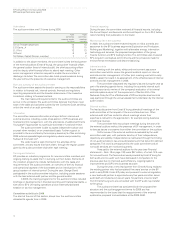BP 2008 Annual Report Download - page 63
Download and view the complete annual report
Please find page 63 of the 2008 BP annual report below. You can navigate through the pages in the report by either clicking on the pages listed below, or by using the keyword search tool below to find specific information within the annual report.
BP Annual Report and Accounts 2008
Performance review
Recoverability of asset carrying values
BP assesses its fixed assets, including goodwill, for possible impairment
if there are events or changes in circumstances that indicate that carrying
values of the assets may not be recoverable and, as a result, charges for
impairment are recognized in the group’s results from time to time. Such
indicators include changes in the group’s business plans, changes in
commodity prices leading to unprofitable performance, low plant
utilization, evidence of physical damage and, for oil and gas properties,
significant downward revisions of estimated volumes or increases in
estimated future development expenditure. If there are low oil prices,
natural gas prices, refining margins or marketing margins during
an extended period, the group may need to recognize significant
impairment charges.
The assessment for impairment entails comparing the carrying
value of the cash-generating unit with its recoverable amount, that is,
the higher of fair value less costs to sell and value in use. Value in use
is usually determined on the basis of discounted estimated future
net cash flows.
Determination as to whether and how much an asset is impaired
involves management estimates on highly uncertain matters such as
future commodity prices, the effects of inflation on operating expenses,
discount rates, production profiles and the outlook for global or regional
market supply-and-demand conditions for crude oil, natural gas and
refined products.
For oil and natural gas properties, the expected future cash flows
are estimated based on the group’s plans to continue to develop and
produce proved reserves and associated risk-adjusted probable and
possible volumes. Expected future cash flows from the sale or
production of these volumes are calculated based on the management’s
best estimate of future oil and gas prices. Prices for oil and natural gas
used for future cash flow calculations are based on market prices for the
first five years and the group’s long-term planning assumptions
thereafter. As at 31 December 2008, the group’s long-term planning
assumptions were $75 per barrel for Brent and $7.50/mmBtu for Henry
Hub (2007 $60 per barrel and $7.50/mmBtu). These long-term planning
assumptions are subject to periodic review and modification. The
estimated future level of production is based on assumptions about
future commodity prices, lifting and development costs, field decline
rates, market demand and supply, economic regulatory climates and
other factors.
The future cash flows are adjusted for risks specific to the cash-
generating unit and are discounted using a pre-tax discount rate. The
discount rate is derived from the group’s post-tax weighted average cost
of capital and is adjusted where applicable to take into account any
specific risks relating to the country where the cash-generating unit is
located. Typically rates of 11% or 13% are used (2007 11% or 13%).
The rate applied in each country is re-assessed each year by analyzing
relevant information.
Irrespective of whether there is any indication of impairment,
BP is required to test annually for impairment of goodwill acquired in a
business combination. The group carries goodwill of approximately
$9.9 billion on its balance sheet, principally relating to the Atlantic
Richfield and Burmah Castrol acquisitions. In testing goodwill for
impairment, the group uses a similar approach to that described above.
If there are low oil prices or natural gas prices or refining margins or
marketing margins for an extended period, the group may need to
recognize significant goodwill impairment charges.
Taxation
The computation of the group’s income tax expense involves the
interpretation of applicable tax laws and regulations in many jurisdictions
throughout the world. The resolution of tax positions taken by the group,
through negotiations with relevant tax authorities or through litigation,
can take several years to complete and in some cases it is difficult to
predict the ultimate outcome.
In addition, the group has carry-forward tax losses in certain
taxing jurisdictions that are available to offset against future taxable
profit. However, deferred tax assets are recognized only to the extent
that it is probable that taxable profit will be available against which the
unused tax losses can be utilized. Management judgement is exercised
in assessing whether this is the case.
To the extent that actual outcomes differ from management’s
estimates, taxation charges or credits may arise in future periods. For
more information see Financial statements – Note 20 on page 135 and
Note 44 on page 174.
Derivative financial instruments
The group uses derivative financial instruments to manage certain
exposures to fluctuations in foreign currency exchange rates, interest
rates and commodity prices as well as for trading purposes. In addition,
derivatives embedded within other financial instruments or other host
contracts are treated as separate derivatives when their risks and
characteristics are not closely related to those of the host contract. All
such derivatives are initially recognized at fair value on the date on which
a derivative contract is entered into and are subsequently remeasured at
fair value. Gains and losses arising from changes in the fair value of
derivatives that are not designated as effective hedging instruments are
recognized in the income statement.
In some cases the fair values of derivatives are estimated using
models and other valuation methods due to the absence of quoted prices
or other observable, market-corroborated data. In particular, this applies
to the majority of the group’s natural gas and LNG embedded derivatives.
These are primarily long-term UK gas contracts that use pricing formulae
not related to gas prices, for example, oil product and power prices.
These contracts are valued using models with inputs that include price
curves for each of the different products that are built up from active
market pricing data and extrapolated to the expiry of the contracts using
the maximum available external pricing information. Additionally, where
limited data exists for certain products, prices are interpolated using
historic and long-term pricing relationships. Price volatility is also an input
for the models. Changes in the key assumptions could have a material
impact on the gains and losses on embedded derivatives recognized in
the income statement. For more information see Financial statements –
Note 34 on page 150. An analysis of the sensitivity of the fair value of the
natural gas and LNG derivatives to changes in the key assumptions is
provided in Financial statements – Note 28 on page 142.
62


